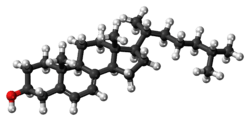7-Dehydrocholesterol
 | |
 | |
| Identifiers | |
|---|---|
| 434-16-2 | |
| 3D model (Jmol) | Interactive image |
| ChEBI | CHEBI:17759 |
| ChemSpider | 388534 |
| ECHA InfoCard | 100.006.456 |
| MeSH | 7-dehydrocholesterol |
| PubChem | 172 |
| UNII | BK1IU07GKF |
| |
| |
| Properties | |
| C27H44O | |
| Molar mass | 384.638 |
| Except where otherwise noted, data are given for materials in their standard state (at 25 °C [77 °F], 100 kPa). | |
| | |
| Infobox references | |

7-Dehydrocholesterol is a zoosterol that functions in the serum as a cholesterol precursor, and is converted to vitamin D3 in the skin, therefore functioning as provitamin-D3. The presence of this compound in human skin enables humans to manufacture vitamin D3 from ultraviolet rays in the sun light, via an intermediate isomer pre-vitamin D3. It is also found in the milk of several mammalian species.[1] In insects it is a precursor for the hormone ecdysone, required for reaching adulthood.[2] It was discovered by Nobel-laureate organic chemist Adolf Windaus.
Location
The skin consists of two primary layers: an inner layer, the dermis, comprising largely connective tissue, and an outer, thinner epidermis. The thickness of the epidermis ranges from 0.08 mm to greater than 0.6 mm (from 0.003 to 0.024 inches).[3] The epidermis comprises five strata; from outer to inner, they are the stratum corneum, stratum lucidum, stratum granulosum, stratum spinosum, and stratum basale. The highest concentrations of 7-dehydrocholesterol are found in the epidermal layer of skin—specifically in the stratum basale and stratum spinosum.[4] The production of pre-vitamin D3 is, therefore, greatest in these two layers.
Radiation
Synthesis of pre-vitamin D3 in the skin involves UVB radiation, which effectively penetrates only the epidermal layers of skin. 7-Dehydrocholesterol absorbs UV light most effectively at wavelengths between 290 and 320 nm and, thus, the production of vitamin D3 will occur primarily at those wavelengths. The two most important factors that govern the generation of pre-vitamin D3 are the quantity (intensity) and quality (appropriate wavelength) of the UVB irradiation reaching the 7-dehydrocholesterol deep in the stratum basale and stratum spinosum.[4] Another important consideration is the quantity of 7-dehydrocholesterol present in the skin. Under normal circumstances, ample quantities of 7-dehydrocholesterol (about 25–50 ug/cm2 of skin) are available in the stratum spinosum and stratum basale of human skin to meet the body's vitamin D requirements.
Interactive pathway map
Click on genes, proteins and metabolites below to link to respective articles. [§ 1]
Vitamin D Synthesis Pathway edit
- ↑ The interactive pathway map can be edited at WikiPathways: "VitaminDSynthesis_WP1531".
See also
References
- ↑ "7-dehydrocholesterol." The American Heritage Stedman's Medical Dictionary. Houghton Mifflin Company, 2002. 21 Jan. 2007. Answers.com. Archived October 25, 2012, at the Wayback Machine.
- ↑ Ed Yong (2012), Thanks to one gene, this fly needs a cactus to escape Neverland Not Exactly Rocket Science
- ↑ Frediric Martini et al. (2006). Human Anatomy. Pearson/Benjamin-Cummings Publishers, p. 89. ISBN 0-8053-7211-3.
- 1 2 Norman, Anthony W. (1998) Sunlight, season, skin pigmentation, vitamin D, and 25-hydroxyvitamin D:integral components of the vitamin D endocrine system. Am J Clin Nutr;67:1108–10.
